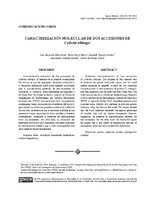Mostrar el registro sencillo del ítem
Molecular characterization of two accessions of Cydonia oblonga
| dc.contributor.author | Alvarado-Marchena, Luis | |
| dc.contributor.author | Flores-Mora, Dora María | |
| dc.contributor.author | Chacón-Cerdas, Randall | |
| dc.contributor.author | Schmidt-Durán, Alexander | |
| dc.contributor.author | Alvarado-Ulloa, Carlos | |
| dc.date.accessioned | 2018-02-27T20:53:53Z | |
| dc.date.available | 2018-02-27T20:53:53Z | |
| dc.date.issued | 2015 | |
| dc.identifier | https://revistas.ucr.ac.cr/index.php/agromeso/article/view/19329 | es |
| dc.identifier.issn | 2215-3608 | |
| dc.identifier.uri | https://hdl.handle.net/2238/9614 | |
| dc.description | Artículo científico | es |
| dc.description.abstract | El objetivo de la presente investigación fue evaluar el uso del espaciador plastídico trnH-psbA y la secuencia codificante matK como posibles marcadores para la caracterización molecular de dos accesiones de membrillo (C. oblonga). Estas provinieron de Argentina y de Costa Rica. El trabajo se llevó a cabo en el Centro de Investigación en Biotecnología del Instituto Tecnológico de Costa Rica (ITCR), durante el año 2014. Los productos amplificados fueron analizados con el software MEGA v6.0 para calcular las distancias genéticas mediante el modelo de Tamura-Nei. Se determinó que la secuencia matK fue la que presentó el mayor porcentaje de sitios variables y distancia intraespecífica, indicando la presencia de polimorfismos entre las accesiones. Por otro lado, la utilización del espaciador trnH-psbA para membrillo, tuvo poca capacidad de discriminación debido a que a nivel intraespecífico este locus presentó menos divergencias. | es |
| dc.description.abstract | The purpose of this research was to evaluate the plastid trnH-psbA spacer and the matK coding sequence as possible markers for the molecular characterization in two accessions of quince (C. oblonga), one from Argentina and the other one from Costa Rica. The study was carried out at Center for Biotechnology Research (CIB in Spanish) of the Technological Institute of Costa Rica (ITCR, in Spanish) during 2014. Amplified products were analyzed using MEGA v6.0 software to calculate genetic distances using the Tamura-Nei model.The results showed that the matK sequence presented the highest percentage of variable sites and the highest intraspecific distance, suggesting the presence of polymorphisms between the two accessions. On the other hand, the trnH-psbA spacer for quince had a low ability to discriminate because, at intraspecific level, this locus showed less differences. | |
| dc.language.iso | spa | es |
| dc.publisher | Revista Agronomía Mesoamericana | es |
| dc.relation.hasversion | https://dx.doi.org/10.15517/am.v26i2.19329 | es |
| dc.rights | acceso abierto | es |
| dc.rights.uri | https://creativecommons.org/licenses/by-nc-sa/4.0/ | * |
| dc.source | Revista Agronomía Mesoamericana | es |
| dc.subject | Filogenética | es |
| dc.subject | Membrillero | es |
| dc.subject | Polimorfismo | es |
| dc.subject | Research Subject Categories::FORESTRY, AGRICULTURAL SCIENCES and LANDSCAPE PLANNING::Plant production::Agronomy | es |
| dc.subject | Marcadores -- Moléculas | |
| dc.subject | Capacidad de discriminación | |
| dc.subject | Phylogenetics | |
| dc.subject | Markers -- Molecules | |
| dc.subject | Polymorphism | |
| dc.subject | Discrimination capacity | |
| dc.title | Molecular characterization of two accessions of Cydonia oblonga | es |
| dc.title.alternative | Caracterización Molecular de Dos Accesiones de Cydonia Oblonga | es |
| dc.type | artículo original | es |
Ficheros en el ítem
Este ítem aparece en la(s) siguiente(s) colección(ones)
-
Artículos [40]



